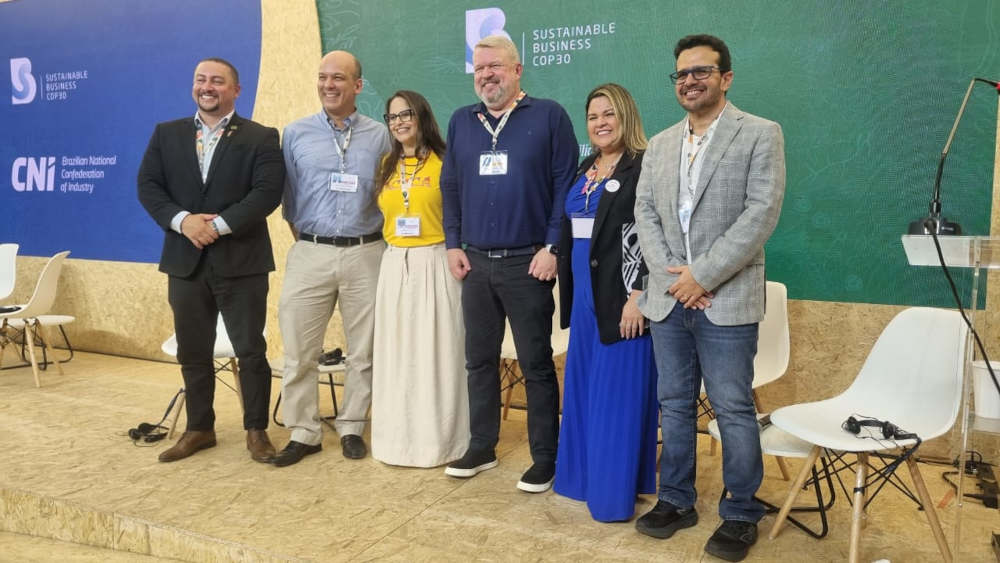A large property in the Brazilian Amazon that had been repeatedly notified for environmental violations due to illegal deforestation and fires in recent years used an official document to hide embargoes and infractions. Busted by state and federal agencies several times and even after spreading flames throughout an extensive burned area of more than 1,200 hectares, Formoso Farm, located in Marcelândia (MT), kept a apparently “clean record” to continue producing grains, raising cattle and selling their production.
Through the fraudulent use of a Rural Environmental Registry (CAR) of another property nearby, the farm owner managed to obtain a provisional authorization for rural operation (APF) from the Mato Grosso State Environmental Department (Sema/MT) in early September last year (2020). Only after alerts and inquiries sent to the agency by Repórter Brasil, still in December 2020, the documentation was cancelled on the 22nd, just a week before the expiration date (December 31st) .
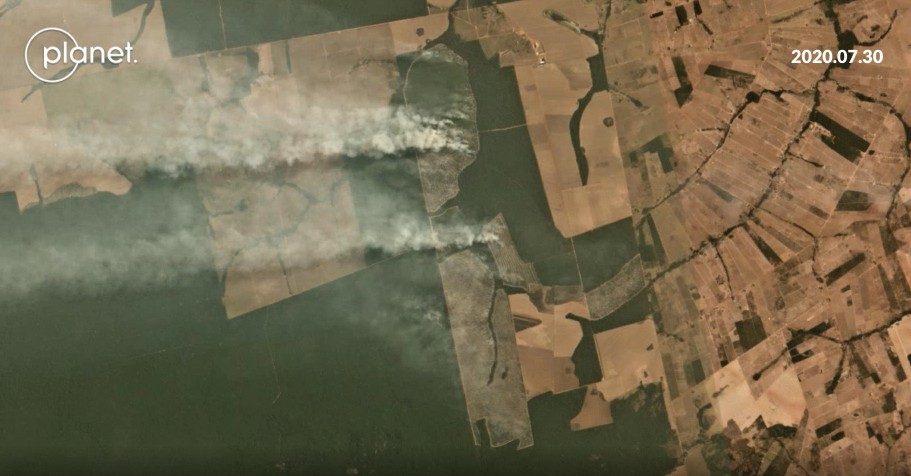
Partial image of the fire area in the Agromaster/Formoso/Formoso II/Mariana Farms; see animation with sequential captures from Planet satellite provided by MAAP Project
After internal analysis, Sema/MT confirmed that the self-declared CAR included in the application (# 38005/2020) for economic activities on 4,800 hectares of the property´s nearly 7,500 hectares had been “created solely to obtain the authorization” and “did not correspond to the Formoso Farm’s area.” Once the irregularity was found, in addition to the annulment of the aforementioned authorization, the State Environmental Department announced that responsibilities “are being investigated so that appropriate measures can be taken”.
There were, according to Sema/MT, “strong indications of improper obtaining of this APF” and “the report of this fact was being forwarded to the Specialized Environment Police (Dema)”.
Between 2016 and 2019, Sema/MT notified the Formoso Farm complex 17 times for environmental violations only (see table below with inspection operations and periods), totalling fines in excess of R$ 3.5 million. Alexandra Aparecida Perinoto, a resident of Sinop (MT), responds individually for most of these violations, in addition to appearing as a beneficiary of the authorizations and the property’s main owner in both land property and environmental documents. Some of the notifications also mention her children. The 2016 inspections resulted in interdictions that are still valid, but, as pointed out by the state environmental department, they refer only to specific areas where irregularities have been found, and their effects “do not extend to other parts of the property” – as provided for in the legislation.
In order to obtain APFs that could “wash” the production of Formoso Farm, granting outward regularity to it, 27 applications were submitted, 20 of them after August 2019. Some months earlier (March to May), two environmental inspections – one from Sema/MT and the other from Brazilian Institute of the Environment and Renewable Natural Resources (Ibama) – detected a series of violations (including declaring embargoed areas inside the property). Of all requests – and even after episode of the fraud and cancellation -, one of them, related to a parcel (Lote 08) smaller than 5% (344.5 hectares) of the entire farm remains valid until the end of 2021. Granted initially in October 2019, the document authorizes the economic use of 178.5 hectares, which is about half of the Lote 8 perimeter and just 3,7% of those wide (lawless and abrogated) liberation of 4,800 hectares.
This flood of applications for APFs took place following operations of CAR register fragmentation – an illegal manoeuvre that violates normative instruction 2/2014 (Art.32) and has been criticized by experts for almost a decade. Environmental organizations and state agents who works with sustainability issues have been denouncing the use of the CAR as an instrument for various forms of deviations
“The CAR was one of the most important elements of the Forest Code of 2012. There are positive aspects associated with it, but the way it was implemented and the gaps that were left over time have been accumulating, generating more loopholes so that it is possible to escape the legislation and cheat some rules”, comments environmental engineer Heron Martins, data analyst at the non-governmental organization (NGO) Center for Climate Crime Analysis (CCCA). “One of the problematic things is the possibility of editing the CAR. The system allows ‘adjustments’ to be made until it is accepted” adds Martins, noting that the process of CAR validation by state agencies moves pretty slowly and remains as an “Achilles heel” of the system.
In the case of Formoso Farm, there was a first fragmentation in three equal parts (less than 2,500 hectares each), with a second level of fragmentation in 21 pieces (more details below). All of these 21 “lotes” were registered as separate enterprises (4 in the name of each of the 3 son/daughters and 9 in the name of Alexandra herself). As for CAR records and APF requests, numerous arrangements have been made (see also ICV´s table below) to ensure at least one valid documentation to trade commodities.
According to Sema/MT, the APF of Formoso Farm “Lote 08” meets the requirements and has been recognized as part of the “base for consolidated use.” That means it was deforested before July 22, 2008 (as provided for in Brazil’s 2012 Forest Code), following the rule established by State Executive Order 262/2019.About the process that extended the authorization (#22096/2019, attached with an environmental commitment term) to the end of 2021, Sema stated that automatic extension for one more year was granted to all APF due to the publication of Decree #770 of December 29th 2020.
“Tricks” series
Many schemes have been used by private actors that result in deforestation and fires in native forest areas in the Amazon, in order to continue their economic activities even after repeated environmental violations and sanctions. Taking some emblematic cases based on monitoring of Amazon destruction throughout since June 2020, Repórter Brasil publishes the story of the Formoso/Agromaster Farm as the starting point for a wider overview of the “tricks” used to circumvent the various norms and regulations that at least seek to contain the impulse driving destruction cycles.
Resulting from shared and collaborative work with various partners, these investigative efforts reveal that even private properties supposedly “regulated and monitored” remain in full swing in their violations, expanding large-scale deforestation and fires. That is not just the case of so-called undesignated areas, whose ownership and direct responsibility rest with the State and which have been monitored, notified and interdicted multiple times at both state and federal levels. More than that: due to the weakness of social governance and its tools for curbing and sanctioning violations, production in those properties is not even restricted in any way, and they keep their channels to the market open.
The Formoso/Agromaster case illustrates, in an instructive way, manoeuvrers and subterfuges used by agribusiness agents that resort to several means within the system itself to continue their march, year after year, one harvest season after another. As will be seen in the next parts of this series, they do not seem too concerned with changing their behaviour, which invariably leads to socio-environmental damage.
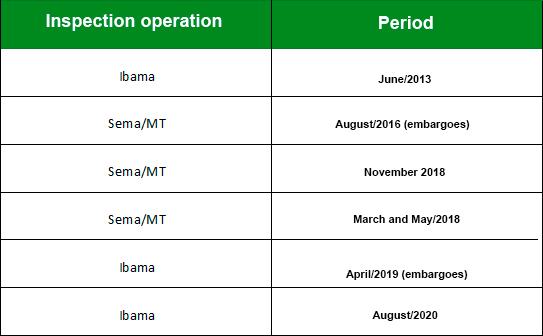
The property as a whole also accumulates violation notifications issued by the Ibama. The first record of illegal deforestation dates back to 2013, when a violation notification was issued to the aforementioned owner for a total fine of R$ 3.44 million. In 2019, inspectors returned to the area and once again found serious and extensive irregularities, which led to another huge fine of more than R$ 8.6 million and the property’s inclusion on Ibama’s interdiction list. Finally, in August 2020, Ibama returned to the area to apply administrative sanctions for noncompliance with the 2019 interdiction and for the fire mentioned above.
Ibama’s press office also confirmed that, in one of the inspections on the Formoso Farm, agents were given a sales contract registered to someone else, which later proved to be fraudulent. According to the agency, the Federal Police (PF) was informed and began the procedure of “transferring the fine to the farm’s real owners.” Repórter Brasil tried to contact the property’s owner Alexandra Aparecida Perinoto by phone but she did not reply.
These illegalities have also developed into in lawsuits filed by both the Mato Grosso State Prosecution Service (MPMT) and the Federal Prosecution Service (MPF). The former framed the cases of those three farms as part of the Satellite Alerts Project, a partnership with Brazil’s space agency Inpe that has looked into major deforestation cases between 2008 and 2019. The Federal Prosecution Service, in turn, filed a public civil lawsuit for R$ 3.5 million in 2017, based on deforestation detected by PRODES/Inpe in 2016 and confirmed by an expert report under the Amazon Protege program. The lawsuit is still pending.
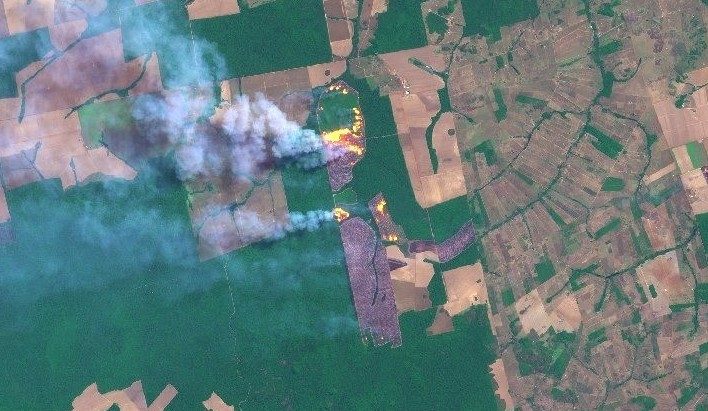
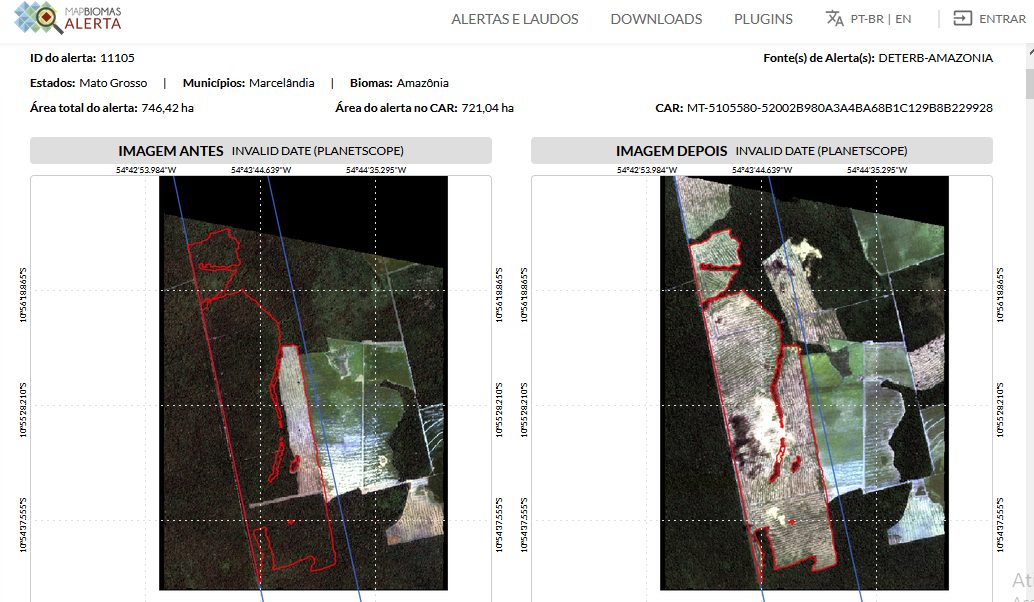
Fires and deforestation
In late July and early August, a big fire spread all over the Formoso Farm complex. According to data from NASA’s Amazon Control Panel and images from other monitoring systems (such as InfoAmazonia) the fire spread over 1,600 hectares, including areas outside the property’s boundaries. That is the equivalent of 1,600 official football fields, more than all the vegetation destroyed in the 2015 dam collapse disaster in Mariana. According to Ibama’s calculations, 1,200 hectares would have been illegally impacted only within the property (since July 1, the state of Mato Grosso had established the fire moratorium, reinforced by a similar Presidential Executive Order that came into force on July 16).
The farms were originally separated as three large adjacent rectangular farms – Formoso/Agromaster, Formoso II and Mariana, according to their records on the Land Management System (SIGEF) of the National Institute of Colonization and Agrarian Reform (Incra) (see images below). They were located next to the Bonjaguá Settlement Project. The very names show that the data provided by the registrants were not clear: on an application for a forest exploitation authorization submitted to Sema/MT in 2008 on behalf of another owner, the Formoso Farm area was spelt as Formosa Farm.
In a more recent document – from 2014, already listing Alexandra Aparecida Perinoto as its single owner – one of the farms appears only as Agromaster Fomento Agrícola III (on SIGEF, it is actually misspelt as “Agrícula”). This confusion of names and letters also involves a legal entity – Perinoto & Sotti Ltda – which had Alexandra Aparecida Perinoto as a partner and was shut down in 2017. Therefore, the discrepancy involving names and those responsible can be considered as a relevant part of the tricks used by private agents (almost always involving family members as well), since in the very lawsuit filed by the federal prosecutors, the web of individuals and companies ended up creating confusion, in addition to the repeated difficulty of notifying those involved.
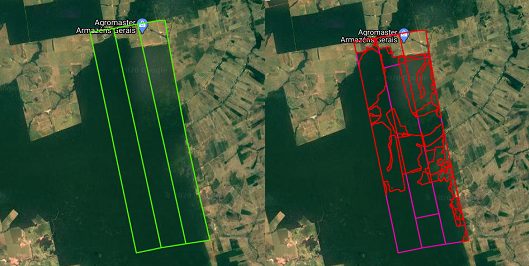
Another common trick seems to combine property names (especially the “replacement” of Formoso with Agromaster) with deliberate land fragmentation strategies – using different instruments such as the Rural Environmental Register (CAR) itself. The strategies are intended to hide connections between agricultural products marketed and specific areas that not only have histories of environmental liabilities but have also been interdicted by both the state and federal governments. Since part of the sanctions was concentrated on portions of the huge area of about 7,500 hectares, it is possible to assume that managers resorted to these “origin management” tricks, attributing the cattle to apparently “clean” areas so that production could be maintained and their products could be marketed.
Along this line, on the Mato Grosso Rural Environmental System (SIMCAR), owner Alexandra Aparecida Perinoto had clearly divided the Formoso II Farm into two separate areas (with 350 and 2,100 hectares) and the Mariana Farm into three others (the Mariana Farm itself, with 1,700 hectares; the Formoso Farm/Lot 08, with 344 hectares; and the Formoso Farm/Lot 14, with 358 hectares). According to documents from inspections, fines and interdictions issued by environmental authorities over the past few years, what was initially registered on SIGEF/Incra as three large farms appears as seven different properties on SIMCAR – each with its respective percentage of deforestation and sanctions (none of them with a valid CAR number).
With this trick, no interdictions appear to the main area of Formoso/Agromaster Fomento Agrícola III, even though 56.9% of its area has been deforested (above the limit of 20% established to guarantee the Legal Reserve in the Amazon biome). As a result of the same chicanery, the Mariana Farm itself has a very low percentage of degradation (35.6%), and separate lots appear intact, such as “Formoso Farm/Lot 14”, since it is smaller and “separate” from the others “lots” that form the whole of the Formoso Farm.
Precisely because of this expedient, the “Formoso Farm/Lot 8” – one of the multiple areas mentioned earlier – created by fragmenting the parallel outlines on the National Rural Registration System (SICAR) – could benefit from a temporary authorization, since it included areas deforested before 2008.
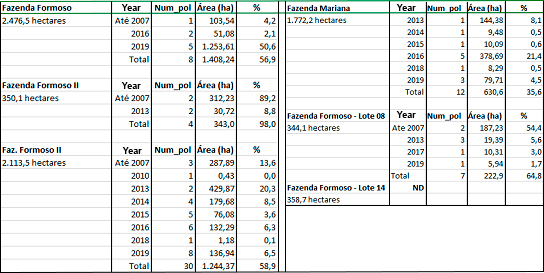
As for state agencies, in addition to the flaws that granted temporary authorizations for farming operations, two other aspects stand out. The first one is the time it takes for the system to process these violation notifications. Only six out of the 17 notifications related to these areas issued by Sema/MT had their decisions ratified to confirm the fines (no fine has been actually paid) and maintain interdictions. Only one of them, issued to one of Perinoto’s daughters, was considered as overdue debt because no appeal was filed. The Attorney General of the State of Mato Grosso (Procuradoria Geral do Estado, in Portuguese) informed Repórter Brasil, through its press office, that the filing of the tax execution was carried out in March 2021 at the 6th Civil Court of Sinop city.
According to PGE/MT, a declaration of overdue debt is related to its origin – in this case, the violation notification issued to Alexandra Aparecida Perinoto. If environmental agents find that the activity was underway or involved the notified party while they were issuing the notification, the overdue debt declaration will reflect that. In practice, however, in the case of the Formoso Farm, violation notifications are being issued both to Perinoto and her daughter, “except that the procedures were not concluded simultaneously,” that is, “if the procedure against Perinoto is concluded and the fine is not paid, her own name will also be listed as debtor.”
Inconsistency among the several systems – whether they are related to land property or environmental issues – is the second relevant aspect regarding the role played by state institutions, which are also somehow “willing” to be tricked. Inconsistency and miscoordination end up making life easier for violators who, aware of these legal loopholes, create some sort of deliberate mess involving names and boundaries to further hinder enforcement and regulation – which are not in the state’s interest only but also in the public’s. According to an assessment conducted by the technical staff at Centro e Vida Institute (ICV), who provided support in data analysis, “integration between agencies and distinct branches of government is highly flawed” and there are also multiple “bottlenecks in terms of technical capacity and work.”
Still according to the assessment, environmental, forest and land management systems at both state and federal levels have integration problems, so that a lot of data are simply not share or compared. Incra’s SIGEF was created not long ago, and the CAR still has to undergo its crucial validation stage. According to ICV’s technical assessment, all agencies are understaffed and have less equipment and lower technical capacity than would be needed to integrate these systems, databases and information. Without these structural conditions, it is not possible to create intelligence that really enables environmental enforcement and monitoring to “work at full potential.”
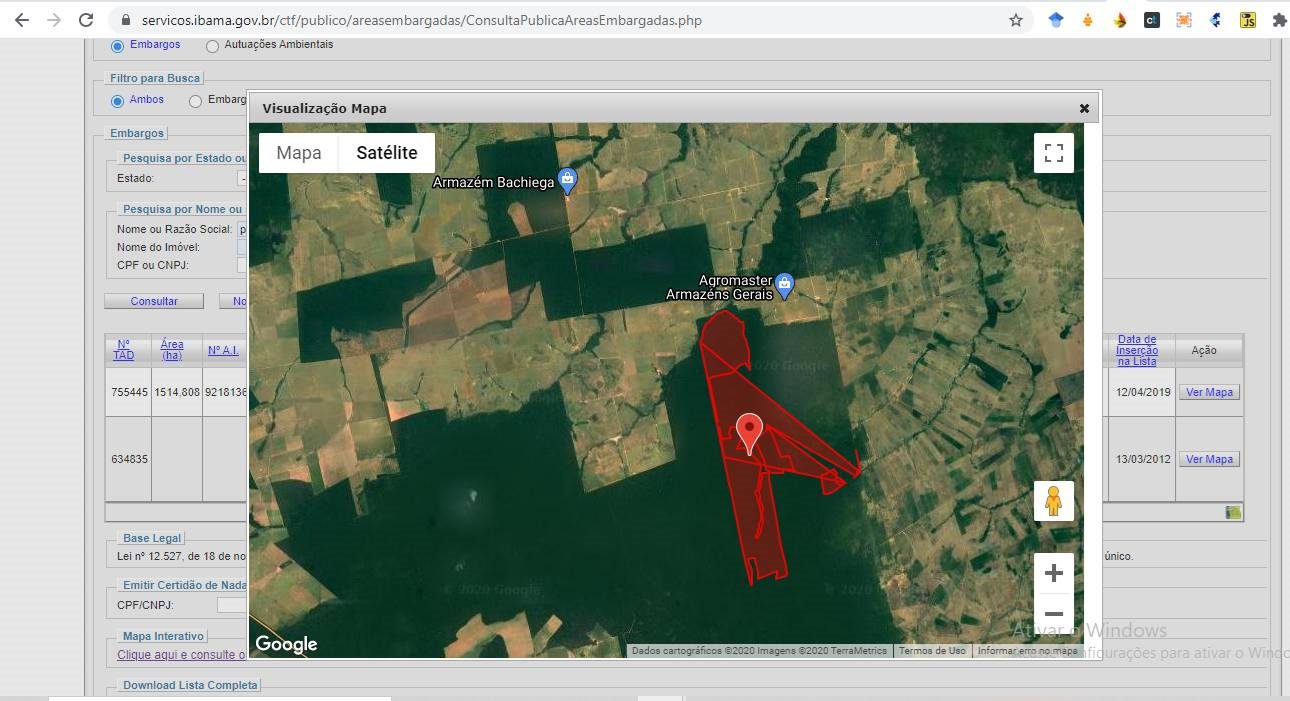
Supply chain
Having used these several tricks and even with such a large number of major environmental violations, agricultural activities continued and even expanded on the three farms. Based on an exclusive supply chain survey, Repórter Brasil found records of direct soybean supply from Agromaster III to two companies: Fiagril and Aliança Agrícola do Cerrado. Both sourced soybean from the Formoso/Agromaster III Farm in the first half of 2019.
Fiagril, a member the Brazilian Association of Vegetable Oil Industries (Abiove), and the Agricultural Alliance of the Cerrado, a member of the National Association of Cereal Exporters (Anec), are signatories to the Soy Moratorium, a 14-year-old intersector voluntary agreement to ban trading in commodities supplied by Amazon areas deforested after 2008 – the date set by the Brazilian Forest Code. Repórter Brasil contacted the two companies – Fiagril, currently linked to China’s Dakang, and Aliança, part of Luxembourg-based Russian conglomerate Sodrugestvo – but they did not respond to our requests.
While transactions happened in the same semester as Ibama’s environmental inspections (April 2019) that found serious illegal activities on those farms, the sequence of illegalities undermines any claim that the companies knew nothing of the heavy environmental liabilities behind Agromaster/Formoso’s production. First, because the farms had been interdicted by Sema/MT since 2016. Second, because there are records of soybean sales to the companies after the area was included on Ibama’s interdiction list in April 2019.
Therefore, the vast illegal fire in July and the fine applied by Ibama to those farms for noncompliance with the August 2020 interdiction are the “crowning” of a long process of irregularities. Such issues had not been detected by public and private regulations, and the farms found partners for Amazon devastation in Brazilian and foreign markets.
In addition to broader studies and surveys showing the links between soybean plantations and Amazon deforestation – such as those conducted by ICV/Trase or UFMG professor Raoni Rajão – the case of the Agromaster III Farm (Formoso/Formoso II/Mariana) illustrates the fact that even huge areas and producers repeatedly caught and charged with environmental crimes, including those on environmental interdiction lists, can use several “tricks” to remain in the commodity export market with relative ease and calm.
Ibama’s own press office pointed out to Repórter Brasil that “interdicted agents often use third parties to evade sanctions and sell products from interdicted areas.”
Heron Martins, who took part in many studies on the subject (including the “Amazon illusion” of the Legal Reserve, whose percentage of 80% is effectively applied only to 22.75% of the 389 thousand properties located in the biome highlights the existence of a specific expression to characterize these “tricks” to cheat the supply chain tracking systems based on CAR registers: “leakage” (“vazamento”, in Portuguese). “What I noticed over time is that several editions of these CAR records seek, among other things, to exclude deforestation: both past and those that are yet to occur. When the environmental agency or the trading agent looks only at that CAR, there is no overlapping deforestation. This is a way of circumventing – and there are still many others”.
